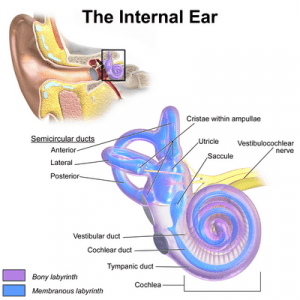Tinnitus and the Ear

Tinnitus and the ear: The ear first …
The ear is a complex organ that is present in all vertebrates.
It has several features:
- It is the seat of the sense of hearing. As such, it captures and interprets sounds. It translates the vibrations of the air around us into micro electrical signals that will then be interpreted by the brain.
- It also plays an important role in the balance of our body, whether it is still or moving. But we will not be more interested in this aspect today.
- Don’t forget the aesthetic side: earrings, piercings, etc.
The word ear most often refers to its visible outer part, the pinna. However, the word also applies to the entire hearing system, which is divided into three parts: The outer ear, middle ear and inner or internal ear.

The outer ear consists of the pinna and the external auditory canal.
The forms and folds of the pinna are intended to direct and concentrate the sound vibrations towards the auditory canal.
The auditory canal has the shape of an acoustic horn decreasing in diameter as one approaches the bottom where is the tympanum.
The middle ear includes the tympanum as well as the auditory ossicles. They are three very small bones. From the outside to the inside: the hammer, the anvil, and the stirrup. Their names come from their characteristic forms.
The inner ear is the most complex part : it is the seat of hearing, but also of the organ of balance.
It includes the oval window, the vestibule, the cochlea and the internal channels as well as the connections to the auditory nerves that are connected to the brain.

Now let’s see how it works
The vibrations of the tympanic membrane are transmitted along the ossicles chain of the middle ear, up to the stirrup.
The movements of the stirrup are then transmitted to the cochlea via the oval window.
The cochlea is a hollow organ shaped like a snail shell. It is lined with cells called stereocilia. These cells are arranged along a membrane which divides the cochlea into two chambers.
All the stereocilia and membranes that are attached to them constitute the organ of Corti.
Finally, a word about the Eustachian tube: it connects the middle ear to the nasal cavities to ensure equal pressure on both sides of the eardrum.
But let’s go back to the stereocilia that fill the cochlea.
They are set in motion by the vibrations transmitted through the middle ear then the first elements of the inner ear.
The stereocilia have the particularity to transform the movement of their lashes into electric micro signals.
It is therefore at the cochlea level that the mechanical signal becomes an electrical signal.
These electrical signals will then pass through the auditory nerve to the brain.
Our brain builds its representation of sound from these electric micro signals that move through its neural circuits.
Along the cochlea, each cell responds preferentially to a certain frequency. It is this specificity of the cells that will then allow the brain to differentiate the pitch of the sounds.
Thus, the stereocilia closest to the base of the cochlea (close to the stirrup) respond preferentially to the acute ones. Those located at the furthest (last turn of the cochlea) respond on the contrary to the low frequencies.
The electrical signal transmitted to the brain will be interpreted as a tone of pitch (frequency) corresponding to the group of cells that have been excited.

Are you still there?
To sum up: the vibrations of the air received by the eardrum are transformed in the inner ear into micro-electrical signals that our brain will interpret.
The little birds singing in the trees, the neighbor’s lawn mower, that little tune in your head. All this is represented in our brain by micro-electrical signals.
The degradation or loss of certain stereocilia mechanically causes hearing loss in the corresponding frequency range.
It is important to note that damaged or destroyed cells do not regenerate.
Tinnitus and the Ear: Tinnitus now.
Now let’s see our intimate ‘friend’ the tinnitus…
About 20% of the population suffers from hearing problems and more than the half of them are victims of tinnitus. Tinnitus is therefore among the most common health problems today, and the trend is increasing.
Tinnitus can be classified into two categories:
• The so-called objective tinnitus that can be clearly linked to an identified cause. By treating the cause, we treat tinnitus. It’s the simplest, but it’s only about ten percent of the total.
• In all other cases, it is more complicated…
Définition : Tinnitus are noises – whistling, whistling, … – that are heard in an ear (or both), either temporarily or continuously without having being emitted by an external source.
In other words, to have a tinnitus is to hear a sound, a noise that does not exist elsewhere than in your head.
Each tinnitus is unique, and the way it manifests may be very different from one individual to another.
Tinnitus is therefore the result of a malfunction of the auditory system. Several causes can be considered. Among them, say ear aging, acoustic trauma, or some ear pathologies.
But at what level is the culprit? The ear? The brain? Both?
It seems that in most cases, tinnitus occurs when the brain attempts to adjust for hearing loss.
Partial loss of auditory input from our ears will then lead to some reorganization of the brain neurotics circuits involved in sound representation: it’s tinnitus.
There is now a large consensus within scientists and doctors working on tinnitus understanding and treatment that the process requires a comprehensive approach in which the ear and the central nervous system must be considered together.
Summary: In most cases, tinnitus is a sound mistakenly created by our brain. This usually is a brain reaction to some hearing loss.




